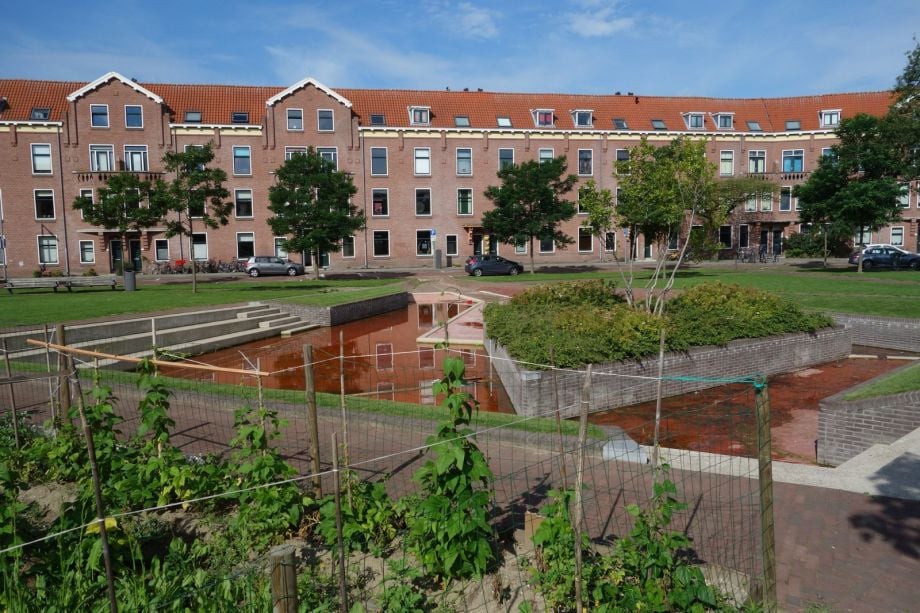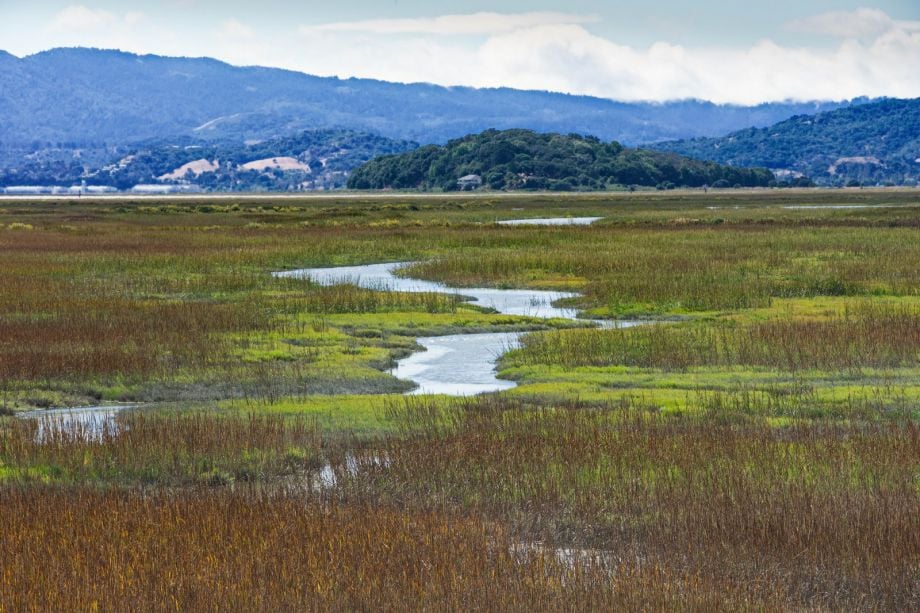Are You A Vanguard? Applications Now Open
A skyway curves through Singapore's "supertrees," in the 101-hectare Gardens by the Bay. The giant metal structures house vertical gardens and capture solar power and rainwater; they range from 80 to 160 feet in height.
Photo by Robert GLOD via Flickr
This is your first of three free stories this month. Become a free or sustaining member to read unlimited articles, webinars and ebooks.
Become A MemberEDITOR’S NOTE: The following is an excerpt from “Life After Carbon: The Next Global Transformation of Cities,” by Peter Plastrik and John Cleveland, published by Island Press. In it, the authors identify 25 “innovation labs” around the world — cities reinventing themselves to combat climate change. Here, they discuss cities that have embraced green infrastructure as a means of “renaturing” the built environment.
Melbourne and other cities such as Portland, Oslo, San Francisco and Singapore are embracing a far-reaching shift in their mental models about the city’s relationship to nature. In modern times, the city has been thought of as the dominant context in the natural environment; its physical, economic, and social needs were to be met by shaping the landscape near and far. Cities cleared and built upon the land, sweeping away natural habitats and species. They engineered control over waterways, consumed vast amounts of natural resources, and dumped enormous amounts of waste. Their inhabitants lost direct connection with the natural world and its processes. Urban areas did contain parks, garden areas, and tree-lined streets, but these mostly were limited “postage stamp” parcels in the larger urban scheme of things.
As urban denaturing proliferated in the 19th and 20th centuries, conservation and environmental movements arose to protect and preserve natural spaces — outside of cities. “You enjoyed nature by leaving the city and going to visit someplace: Yosemite, Yellowstone,” reflects Timothy Beatley, a professor of sustainable communities and prominent advocate of green urbanism. Today, nearly 15 percent of all land on the planet is under some type of protected status. Other efforts added public parks within the city to provide residents with relief from urban stresses and improve public health. Some urban designers promoted the development of “garden cities,” smaller communities that contained green space and were surrounded by green belts. However, as Beatley notes, “most visions of a modernist city seemed not to include nature.” The emerging idea inverts the modern-city hierarchy, restoring nature, instead of the city, as the dominant context. “We’re discovering,” Beatley says, “that a modern city should understand itself as a city in nature.” Melbourne, whose residents have cherished the forest within their city, now talks instead about being a city within a forest. Singapore, a dense city-nation of more than five million people, once envisioned itself as a city with gardens but now sees itself as a city within a garden. The city remains the shaper of its built environment, but it shapes with an altered perspective. Cities also apply renaturing to the scale of the neighborhood, district, and precinct. Melbourne’s overall urban-forest plan, for instance, includes tree-canopy building plans for each of the city’s 10 precincts that the city codesigned with community members. The district scale is significant because ecosystems and environmental conditions, as well as vulnerability to flooding and heat, vary throughout an urban area. Part of urban renaturing is a restorative exercise, a way to reinstate balance and sustainability to the city’s relationship with nature. Another part introduces new designs to a city’s space. “It is a bit ‘back to the future,’ but it’s also a creative new future,” says Beatley. “There are elements of the old, but there are entirely new things: the incorporation of nature into the vertical realm [walls and facades of buildings], for instance. Even the notion of ‘hybrid nature’ as seen in Singapore’s ‘supertrees’: large, human-designed and built metal objects that house living plants.”
When cities renature themselves, they pursue three distinct, interrelated applications of the idea. They expand the use of green infrastructure. They protect and enhance ecosystems and biodiversity. And they provide people with ways to immerse in nature. Each of these methods involves innovative practices used at multiple urban scales, and each applies to new developments on “virgin” or cleared sites and to retrofitting of densely built parts of the city.
Cities use various green-infrastructure methods — rain gardens, rainwater harvesting, bioswales, permeable pavement, tree canopies, green space, green roofs and walls, constructed wetlands, and more — to address excess stormwater, excess heat, rising sea levels, and other practical problems. This is not a new practice; for centuries, architects, builders, landscapers, and city planners have tapped nature’s capabilities to absorb and channel water and to cool the air. But green infrastructure has gained significant momentum in local government planning and policy worldwide as a favored way to respond to climate change and to increase cities’ sustainability and appeal. The impetus stems from three factors.
First, experimentation and research are increasing the performance, predictability and reliability of green infrastructure. The US Environmental Protection Agency’s website alone contains links to more than 50 performance studies and databases and numerous other scientific and regulatory agency research, modeling tools for designing and costing, guidebooks for operations and maintenance, and design manuals.
Second, cities find that using green infrastructure instead of or in combination with “gray, hard” infrastructure can provide cost savings — reducing initial construction costs and holding down operational and maintenance costs due to less need for labor and heavy equipment. This is especially true when it is used for stormwater management.
Third, green infrastructure can deliver other important value for a city, such as improved water and air quality, upgraded habitat, and increased recreational space. Cities can quantify these co-benefits, measuring reduction in air pollutants and chronic diseases, for example, and they can assess the financial value of the benefits so that a return on investment in green infrastructure can be assessed.

Benthemplein Water Square, in Rotterdam's Zoho neighborhood, is the world’s first water square — a large public space for mingling, events, and recreation that also serves as a giant rainwater collector. (Photo by William Verbeek via Flickr)
As cities recognize the increased reliability, cost-effectiveness, and co-benefits of green infrastructure, they have expanded the practice from one-off projects to city-scale approaches.
When Copenhagen faced a substantial increase in the frequency and intensity of rainfall, it decided not to expand its sewer system, an expensive “hard” approach to managing excess precipitation. Instead, the city selected a neighborhood, St. Kjeld, as a test site for green infrastructure designed to manage heavy rainfalls, aiming to turn 20 percent of the district’s paved surface into green areas and to retain and manage 30 percent of rainwater rather than have it end up in sewers. The approach prevented damage and traffic disruption during heavy downpours. Then the city committed to invest as much as $4 billion over fifteen years for 300 projects that take the green-infrastructure approach citywide.
When Rotterdam developed its citywide climate-adaptation plan, it selected a neighborhood, the Zoho, in which to pilot the combined use of many green-infrastructure innovations designed to work together to capture, store, and use rainwater or slowly release it into the ground, rather than channeling it into overloaded sewers. The innovations together function as a district-wide “sponge” for water. “These measures are particularly effective in areas with high consumer pressure and little available space, such as the compact city center and the neighboring urban districts,” notes the city’s adaptation plan. The Zoho is a bustling nineteenth-century district with modern buildings and streets. Green infrastructure— soil, plants, trees, and gardens on roofs, in streets, along the facades of buildings—is taking over. Pavement on underused streets and roads has been replaced with permeable pavement that allows rain to filter through into the ground. Rain barrels collect water for reuse in buildings. The district’s greenery works in combination with gray infrastructure. At the district’s heart sits the Benthemplein Water Square, the world’s first water square—a large public space for mingling, events, and recreation that also serves as a giant rainwater collector.
Among the efforts of other cities to cultivate a green infrastructure:
Washington, D.C., decided that instead of building a gigantic holding tunnel to provide extra drainage capacity during heavy rainfalls, it would invest $90 million in large-scale green infrastructure to reduce the amount of stormwater that had to be handled by tunnels.
Paris’s overall greening program includes planting 20,000 trees and creating 10.7 million square feet of green roofs and walls and 81 acres of urban agriculture by 2020.
Mexico City installed more than 226,000 square feet of green roofs, mostly on government buildings, schools, and hospitals and offered private residential buildings a 10 percent property tax break for putting in their own green roofs. “Dramatic advances have been made” in addressing “initial fears—leakage and humidity issues to the property have been completely subdued,” says Tanya Müller García, the city’s secretary of the environment. With the city having modeled the practice, she adds, “green roofing is seen as a component of sustainable design.”
Berlin, with 3.4 million residents living in 343 square miles, has pursued a city-greening strategy since the 1990s—developing nearly 300 miles of green walks for pedestrians and bicyclists and keeping 44 percent of the city’s area in forests, preserves, lakes, and other green and blue spaces. In 2015, it adopted a citywide strategy that included plans for green and open spaces for climate adaptation, building a habitat network for biodiversity, and advancing historical and contemporary landscape architecture, urban agriculture; and nature experiences in the city.
A number of cities have launched efforts to protect and restore the ecosystems and biodiversity of their urban regions. They want to ensure and enhance the delivery of essential services provided by nature outside, as well as inside, their boundaries.
Melbourne’s attention to its urban forest evolved into broader concerns about nature and the city. In various planning processes, it looked at the regional ecosystems of which the city was a part and on which it depended and their animal and plant biodiversity. “By considering our city as a wider ecosystem, there is the opportunity to actively foster connections amongst people, plants, animals, and the landscape,” declares Melbourne’s “Nature in the City” report. Especially important is the Yarra River, 150 miles long, starting in pristine mountain forests, running through the city, and ending in the sea — covering a catchment area of nearly 1,600 square miles, more than 100 times larger than the city. The river is the city’s lifeblood; it provides water supply; supports agriculture, industry, and recreational activities; transports people and goods; and enables urban development. The river, like the city’s trees, is an essential part of Melbourne’s identity and well-being.

San Pablo Bay National Wildlife Refuge, at the northern reaches of the greater San Francisco Bay Watershed. (Photo by John Weiss via Flickr)
In San Francisco, the five feet of sea-level rise projected to occur by 2100 could inundate highways, airports, and some of the estimated $75 billion of property on the city’s shoreline. In response, the city and eight urban counties ringing the San Francisco Bay decided in 2016 to invest $500 million to restore and expand the Bay’s wetlands, a vast tidal-marsh ecosystem that for a century-and-a-half had been severely altered by people. “As the population grew,” writes environmental journalist Jane Kay, “newcomers from around the world brought a diversity of lifestyles, filled the tidal marshes, dumped mine tailings, and brought exotic species by railroad and ship. Later came dams, sewage, oil refineries, and plastic pollution.” The 200,000-acre estuary shrank to about 40,000 acres by 1999. Now, the Bay is expected to serve as a natural buffer against storm surges and rising high tides, absorbing water and energy; assessments have called for the addition of 60,000 acres of marshland. This type of restoration is a newly valued environmental service for many of the world’s cities built where rivers meet the ocean.
The growing urban attention to ecosystems extends to maintaining and increasing an urban region’s biodiversity, which is key to maintaining ecosystem health. “When we allow one species to die,” explains biologist Edward O. Wilson, “we erase the web of relationships it maintained in life, with consequences that scientists seldom understand … we break many threads, and change the ecosystem in ways still impossible to predict.” Singapore developed a City Biodiversity Index to measure its biodiversity and assess progress in maintaining and increasing the number of species. The city published a user’s manual in English and Chinese that 80 cities worldwide have used.
Cities generally use a combination of regulation and investments to manage ecosystems, but to date, there isn’t consistency in this emerging urban practice, and cities lack useful data about ecosystems and species. Cities almost always work in partnership with other government entities that also have control over relevant ecosystems. They advocate for tougher regulation and enforcement to prevent pollution and incentives to preserve agricultural lands from development. They also increase their efforts to reduce consumption of water and other natural resources, which can ease pressure on ecosystems. Some cities are instituting new resource management models, such as integrated water management, which coordinates the traditionally separate functions of providing drinking water, managing stormwater, and treating wastewater, as a way of approaching ecosystems as a whole.
Within cities’ many actions, an emerging practice is the financial valuation of ecosystem services, which helps make the case to policymakers for investments in restoration and enhancement. This valuation typically combines different types of value — financial/economic, social/cultural, short- and long-term, environmental, public health, and insurance value — which makes for notably difficult calculations, because each type of value uses a different analytic framework. For now, valuations tend to be more a way of raising awareness of the ecosystem’s services than of providing a rigorous and reliable return-on-investment model for decision making. In some cases, cities have compared the cost of investing in ecosystem service maintenance and enhancement with the cost of alternative proposals.
New York City, which relies on a 2,000-square-mile upstate watershed to deliver clean, unfiltered water to the city, famously invested $1.5 billion to buy 70,000 acres in the watershed, protect reservoirs from pollution, and subsidize environmentally friendly economic development. The alternative was to spend $6 billion for a large water-filtration plant. The eye-catching savings prompted more than 100 other cities to consider watershed conservation — an investment in an ecosystem service — instead of building filtration plants.
A growing number of cities around the world, including Melbourne and six other climate innovation lab cities — Austin, Oslo, Portland, Rio de Janeiro, San Francisco and Washington, D.C. — are going beyond green infrastructure and ecosystem and biodiversity restoration to harvest nature’s benefits. They are among the 24 city members of the Biophilic Cities Network — communities working in 10 countries to bring more contact with nature into city dwellers’ daily lives.
The term biophilia was defined three decades ago by biologist Wilson as “the innately emotional affiliation of human beings to other living organisms.” Tim Beatley, who started the Biophilic Cities Network in 2013, describes the basis for “biophilic urbanism:” “Human beings need contact with nature and the natural environment. They need it to be healthy, happy, and productive and to lead meaningful lives. Nature is not optional, but an absolutely essential quality of modern urban life.” Beatley’s 2016 “Handbook of Biophilic City Planning and Design” cites a range of studies that show exposure to nature provides emotional, mental, and physical benefits, reducing stress, boosting the immune system, aiding in recuperation from surgery, and increasing happiness. The biophilic approach in cities, Beatley says, responds to “long-term chronic stress, the unhealthiness of indoor living, reconnecting us to family and community. It addresses many pathologies of modern life: emptiness and lack of meaning. There’s a hunger for this.”
Cities committed to a biophilic approach focus on increasing the amount and quality of nature that is present in the city, and on improving access to it. They publicly commit to setting biophilic goals, taking initiatives and other actions — including green infrastructure and biodiversity projects — and using indicators to assess progress. Projects range in physical scale, from sites and buildings to citywide efforts, and in function, from the design of physical space to education and outdoor activities.
San Francisco, for example, has supported the creation of more than 100 street parks and parklets — small parcels of land repurposed as green community space. The city estimates that 98 percent of its residents live within a half mile of a park. The city and region’s public transit authority bought light-rail passenger cars with larger than standard windows to provide riders with better views of the Bay and other sights.
“Human beings need contact with nature and the natural environment. They need it to be healthy, happy, and productive and to lead meaningful lives. Nature is not optional, but an absolutely essential quality of modern urban life.”
Oslo has developed a 226-mile citywide trail system, along rivers and through forests, one of the most extensive city systems in the world. It has designated quiet areas in the city where outdoor, recreational, and cultural experiences are shielded from urban noise.
No city in the world is as green, biodiverse, and biophilic as it could be, Beatley says, but “Singapore comes the closest; it is almost in its own category. The city feels, sounds, and smells different.” What started as a major tree-planting initiative 50 years ago has turned into a multifaceted, citywide renaturing effort. Singapore’s remarkable tree canopy covers about 50 percent of the city. “The city has embraced the idea of biophilic urbanism like no other city yet,” he says. In 2011, Singapore started to install tree-canopied corridors to link parks and natural areas. Now more than ninety miles of connectors serve pedestrians. Green roofs are connected to each other. To provide habitats for all kinds of animals, the city’s forest is designed in layers — ground shrubs, smaller trees, and the overarching tree canopy. More and more buildings feature living walls and vertical hanging gardens. The city turned a straight concrete drainage channel into a two-mile-long river that captures stormwater and winds through refurbished, 153-acre Bishan Ang Mo-Kio Park.
“The important thing,” says Beatley, “is to move cities closer to that immersive experience. And that means looking to many other ways to layer nature into cities… It doesn’t necessarily have to sit in a large contiguous block of forest but could be the sum of many things.”
When cities live and work with nature, instead of against her, they may lose the comforting sense of control that built solutions seem to offer. Depending on green infrastructure to suck up a certain amount of water or cool the air a certain number of degrees or on wetlands to protect property from a certain level of ocean surge may seem riskier than installing concrete sewers and barriers. But as the practice of renaturing urban space advances, its performance is becoming more reliable and predictable and, as we’ve seen, it offers important additional benefits that cities need.
In the climate-change era, however, the relationship that cities have with nature is not limited to figuring out how to obtain the full range of nature’s benefits. Cities are finding that nature, in the form of climate change and its risks, is altering how they can shape the future.
Adapted from “Life After Carbon: The Next Global Transformation of Cities,” by Peter Plastrik and John Cleveland. Copyright © 2018 Peter Plastrik and John Cleveland. Reproduced by permission of Island Press, Washington, D.C.

Peter Plastrik was born in Paris, grew up in New York City, and lived in four cities in Michigan. He is co-founder and vice president of the Innovation Network for Communities (INC), established in 2007. Along with John Cleveland, he was a founding consultant to the Carbon Neutral Cities Alliance and helped it develop its strategic plan and Innovation Fund. He also consulted closely with the Urban Sustainability Directors Network (USDN) and managed USDN's Innovation Fund. Pete has been the lead author on several INC reports about cities and climate change: “Essential Capacities for Urban Climate Adaptation,” supported by the Summit Foundation, and “Leadership by US Cities Innovations in Climate Action,” supported by Bloomberg Philanthropies. He is coauthor with John and Madeleine Taylor of “Connecting to Change the World: Harnessing the Power of Networks for Social Impact” (2014). He coauthored two books with David Osborne: “Banishing Bureaucracy: The Five Strategies” (1997) and “The Reinventor's Fieldbook: Tools for Transforming Your Government” (2000). He lives on Beaver Island in Lake Michigan with his wife, Deb, and their pugs.

John Cleveland was born in Alexandria, Virginia, and spent the first 12 years of his life living in small Indian villages on the Yukon River in Alaska that are now “ground zero” for climate change impacts. Living in remote wilderness gave him an appreciation for the power of Mother Nature and the truth of the admonition “Don't mess with Mama!” Since Alaska, he has lived outside of Boston and in several cities in Michigan, where he worked first in state government economic development and then as a strategy consultant to small and medium-sized manufacturing companies, most of them automotive suppliers. Along with Pete Plastrik, he is a co-founder of the Innovation Network for Communities and has worked with Pete in supporting the growth of the Urban Sustainability Directors Network and the launch of the Carbon Neutral Cities Alliance. He is coauthor with Pete and Madeleine Taylor of “Connecting to Change the World: Harnessing the Power of Networks for Social Impact” (2014). He serves as the executive director of the Boston Green Ribbon Commission, a CEO network that is supporting the development and implementation of the City of Boston Climate Action Plan. The Commission work has given him a deep appreciation for the nuts and bolts of city-based climate mitigation and adaptation strategies. John lives with wife, Michelle, in Tamworth, New Hampshire, where he greatly enjoys hiking, skiing, biking, and building stone walls.

20th Anniversary Solutions of the Year magazine